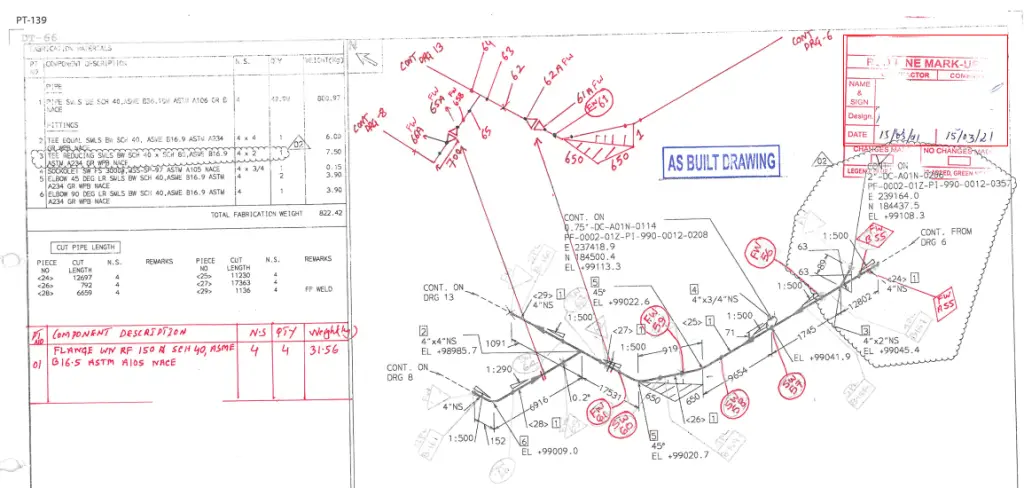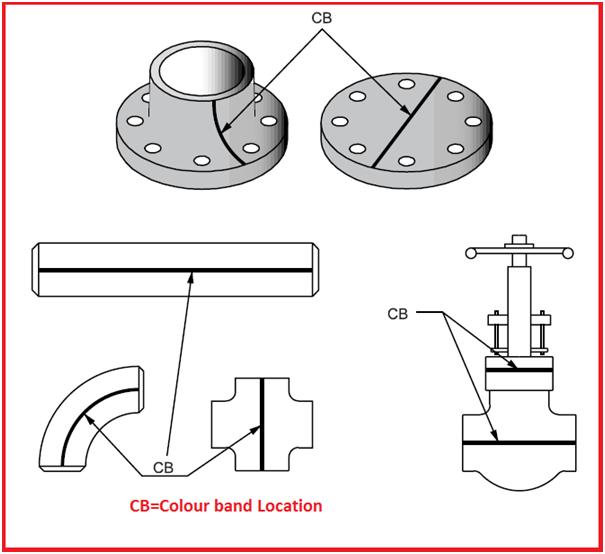As-built drawings are engineering drawings that depict the actual physical characteristics of a plant, building, or structure as it exists once the construction is complete. During actual plant construction, there may be many deviations from the original design drawings. Those changes or modifications are marked on the original drawing with red colors to prepare as-built drawings. Because of these red hand marks over the original design drawing sheet, as-built drawings are also known as red-line drawings. In this article, we will learn the importance of piping as-built drawings.
What is an As-built Drawing?
Preparing as-built drawings is one of the main processes of every construction project. An as-built drawing is an engineering document that depicts each and every modification, field change, shop drawing change, pipe routing change, extra work, etc. In a single sentence, an as-built drawing can be defined as an engineering drawing that informs any design change/deviation from the original design document. As-built drawings are also known as record drawings. Fig. 1 below shows a sample as-built drawing of a piping isometric.

As-built Drawing Requirements
As-built drawings provide several benefits, including:
Documenting the actual plant construction: As-built drawings provide information on the actual plant that is constructed at the site. Precise details about the changes performed at any interim construction stage are known from the as-built drawings. The record of the actual physical characteristics of the pipes, buildings, or structures are required for maintenance, repairs, and future renovations, and the as-built drawings serve those purposes.
Updation of design 3-D models for future use: The information shared through the as-built drawings is used to update the 3D design models to match the actual site configuration. These help in easy tracking for future works. As-built drawings can provide information that can be used for future expansion or remodeling of the project.
Facilitating asset management: By providing a comprehensive record of the physical characteristics of an actual plant, structure, or building, As-built drawings help with proper asset management.
Saving time and money: As-built drawings can help in identifying potential issues before they become major problems, which in turn saves time and money in the long run.
Future Buying: As-built drawings are an important document that provides future buyers with a clear idea of what he is getting for their price. It also forms a strong foundation to conduct any future modifications.
Who is Responsible for As-built Drawings?
The responsibility for preparing red-line or as-built drawings typically falls on the architect, engineer, or contractor who is responsible for the actual plant or building construction. For an oil and gas project, the site engineers create the as-built drawings. Any design changes that site engineers had to make during construction due to any unforeseen reason are marked as part of the as-built drawing.
In some cases, a separate team or individual may be hired specifically to create as-built drawings. However, the person responsible for creating as-built drawings must have a comprehensive understanding of the plant, structure, or building to accurately document its actual physical characteristics.
Later, if anything changes during the maintenance work, those changes must be recorded by the concerned maintenance engineers. There could be various reasons for deviations from the actual design drawing and all those changes must be updated in the as-built drawing and properly stored for future reference.
Note that in some cases, the plant owner made the creation of an as-built drawing a criterion for successful project handover and commissioning. Also, certain local regulations need final as-built drawings as part of certifications, permits, inspections, and legal issues.
Contents of an As-built Drawing
As-built documentation shall comprise the data that is critical for the safe and efficient operation of the plant or facility after commissioning and handover. As-built drawings record construction changes to produce sufficient information. In general, a typical as-built drawing should include the following details:
- Changes in materials, dimensions, installations, fabrications, locations, etc.
- Dates that changes were made.
- Related shop drawings and appendices
- Changes made as a result of the final inspection.
- Unanticipated obstacles confronted and solutions decided.
- Any specific design change
- Working outside the project scope
As you can see in Fig. 1, for the as-built piping isometric, the pipe route change with proper dimension and component description is mentioned clearly in red ink. The document is stamped as As-Built and the dates on which the changes are mentioned are clearly depicted.
Characteristic Features of As-Built Drawings
Even though the creation of as-built drawings can vary a bit from one organization to another. They usually have the following features:
- As-built drawings must be prepared during or immediately after the construction of the facility.
- The changes shall be marked in red ink over the original drawings. For small projects, as-built drawings are usually done by hand-marking with pens. However, bigger projects can use software, typed documents, etc.
- All as-built drawings must be clearly stamped as As-built.
- The changes and description must be clear.
- Abbreviations are usually not used in as-built drawings.
Construction Drawings vs As-Built Drawings: Differences between As-Built Drawing and Construction Drawing
Construction drawings and as-built drawings are two different types of architectural or engineering drawings that are used in the construction process. The main differences between the two are:
- Purpose: Construction drawings are used to guide the construction process, while as-built drawings are used to document the actual physical characteristics of a building or structure after it is completed.
- Content: Construction drawings typically include detailed plans, elevations, sections, and other information that is necessary for the construction process, such as specifications and material lists. As-built drawings, on the other hand, include information on the actual physical characteristics of the building or structure, such as the location of walls, doors, windows, and other features, as well as the location and details of electrical, plumbing, and mechanical systems.
- Timing: Construction drawings are created before construction begins, while as-built drawings are created after construction is complete.
- Audience: Construction drawings are primarily used by contractors, builders, and construction workers to build the project, while as-built drawings are used by the building owner, maintenance staff, and building authorities for reference, compliance, and future use.
- Accuracy: Construction drawings are based on the design plans and may include some assumptions or estimates, while as-built drawings should be as accurate as possible, they are based on the actual physical characteristics of the building or structure.
- Updating: Construction drawings are only used during the construction process and are not typically updated, while as-built drawings are updated as the building changes over time to reflect its current state.
Final Thoughts
Even though as-built drawings are so important, they often lack the right kind of motivation and commitment, and many a time proper record is not kept. Sufficient data at a deep enough level is sometimes not captured. Some strategies that can improve the creation of as-built drawings are:
- Preparation of as-built drawings should start as soon as construction starts.
- As-built has to be made culture for every project.
- Various tools like Laser scanning, BIM data, Actual site photos, etc can improve the quality of the as-built information.
Online Video Course on Piping Isometrics
If you wish to explore more about piping isometrics, you can opt for the following online video course









Thank you for your sharing of the good material
Hello
I am Mehdi from Iran. I have sent you a message before, but unfortunately WhatsApp is a filter in Iran.
I have a question.
Do you have any valid oil and gas projects regarding ASBUILT implementation Procedure?
If you have the procedure, send them to my email
BODBAR.BUPC@GMAIL.COM
I am asking because I myself work in a design company, and the contractor did not execute a series of works according to the plan and says that I have to change the plans.